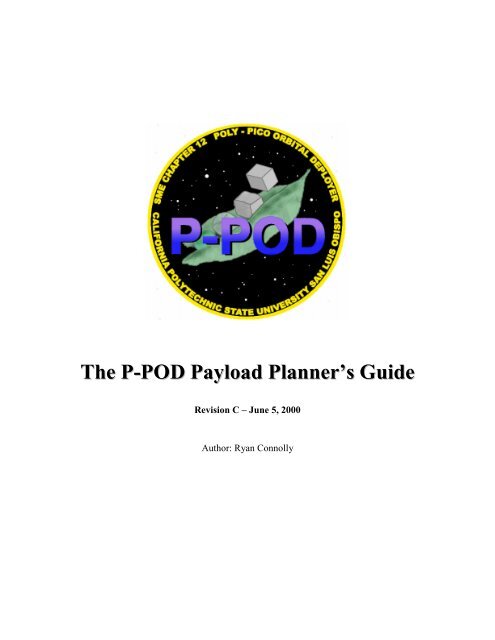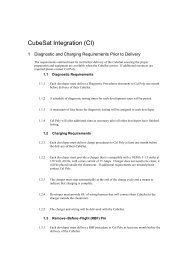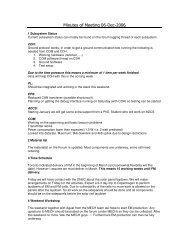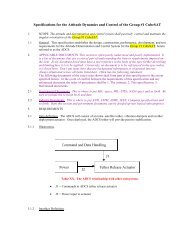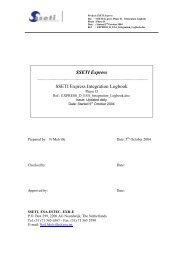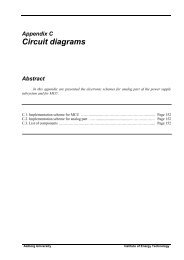The P-POD Payload Planner's Guide
The P-POD Payload Planner's Guide
The P-POD Payload Planner's Guide
You also want an ePaper? Increase the reach of your titles
YUMPU automatically turns print PDFs into web optimized ePapers that Google loves.
<strong>The</strong> P-<strong>POD</strong> <strong>Payload</strong> Planner’s <strong>Guide</strong><br />
Revision C – June 5, 2000<br />
Author: Ryan Connolly
P-<strong>POD</strong> <strong>Payload</strong> Planner’s <strong>Guide</strong>: Revision B – 5/15/00 2 of 19<br />
1. INTRODUCTION<br />
<strong>The</strong> Space Development, Manufacturing & Integration (SDMI) Team is positioning Cal<br />
Poly, San Luis Obispo to be at the center of small satellite development. Working with<br />
Stanford’s Space Systems Development Laboratory (SSDL), the goal is to produce a<br />
standardized platform for small orbital experiments. Known as CubeSats, these tiny space<br />
vehicles are classified as PicoSatellites, meaning that the entire satellite weighs less then<br />
one kilogram. <strong>The</strong> 10-centimeter cubes are designed to house small experiments that<br />
otherwise would be cost-prohibitive to flight validate. Universities, alongside industrial<br />
and governmental interests, will be able to place their own CubeSats into orbit using our<br />
standardized deployment system. Cal Poly’s own satellite, PolySat, will be one of the<br />
first of these new CubeSats.<br />
<strong>The</strong> SDMI is leading the way in the development of this deployment system known as<br />
the P-<strong>POD</strong> (Poly Picosatellite Orbital Deployer). <strong>The</strong> two versions of the deployer will<br />
mount to various launch vehicles, including the Delta II and the Minotaur. <strong>The</strong> maiden<br />
voyage for P-<strong>POD</strong>1 and P-<strong>POD</strong>2, along with PolySat is tentatively scheduled for Late<br />
Summer 2001. <strong>The</strong> total number of CubeSats launched is yet unknown, but the manifest<br />
could reach upwards of fifteen CubeSats on the maiden voyage.<br />
Cal Poly will oversee CubeSat development worldwide, and shall orchestrate all<br />
launching services with the launch providers. <strong>The</strong> integration design team is responsible<br />
for overseeing all incoming CubeSats, and verifying that they meet the design<br />
requirements set forth in the P-<strong>POD</strong> <strong>Payload</strong> Planner’s <strong>Guide</strong>, which will be available to<br />
all interested parties. This ambitious interdisciplinary project, with students from all<br />
engineering majors and even several non-engineering majors, embodies the Cal Poly<br />
‘Learn by Doing’ credo in every respect.<br />
<strong>The</strong> purpose of the <strong>Payload</strong> Planner’s <strong>Guide</strong> is to define clearly and carefully all CubeSat<br />
design requirements and all requirements for their interface with the deployer. This<br />
document is divided into the following sections:<br />
1. Introduction<br />
2. CubeSat Deployer Description<br />
3. CubeSat Physical and Electrical Requirements<br />
4. CubeSat Operational Requirements<br />
5. Delivery Deadlines and Pricing<br />
Please refer to the SDMI website for more information regarding the project:<br />
http://www.calpoly.edu/~aero/polysat
P-<strong>POD</strong> <strong>Payload</strong> Planner’s <strong>Guide</strong>: Revision B – 5/15/00 3 of 19<br />
2. PICOSATELLITE DEPLOYER DESCRIPTION<br />
This section of the document shall provide an overview of the CubeSat environment<br />
while onboard the deployer. <strong>The</strong> CubeSat provider shall be briefed on the following<br />
criteria required for integration into the deployer:<br />
2.1 Deployer System Overview<br />
2.2 CubeSat Containment and Deployer Interface<br />
2.3 CubeSat Launch Environment<br />
2.4 P-<strong>POD</strong> Orbital Environment<br />
Please refer to Section 3 for explicit CubeSat requirements.<br />
2.1 Deployer System Overview<br />
<strong>The</strong> P-<strong>POD</strong> System has two distinct release platforms, each with a unique deployer that<br />
has different requirements on the CubeSats themselves.<br />
2.1.1. Platform #1: P-<strong>POD</strong>1<br />
With this configuration, the deployment system requires less design refinement for the<br />
CubeSats. <strong>The</strong> published specification tolerances for the CubeSat, as well as the outer<br />
mounting surface area provide for easier manufacturing of the CubeSats. <strong>The</strong> ultimate<br />
aim of this system is to provide deployment services to clients with limited<br />
manufacturing capabilities, such as universities and high schools, since the P-<strong>POD</strong>1 can<br />
accept a wider variation in CubeSat design.<br />
<strong>The</strong> mounting configuration for P-<strong>POD</strong>1 has three CubeSats per “<strong>POD</strong>,” with each<br />
CubeSat located by their corners via a series of mounting blocks. <strong>The</strong> three CubeSats sit<br />
next to one another on a base that slides vertically on roller slides, and two doors, which<br />
remain closed and locked until deployment, confine the entire base. Two Compression<br />
Springs provide the launching force, and the doors are opened via a cam system that<br />
ensures that the doors are fully opened when the base reaches its maximum height.<br />
Figure 2.1. P-<strong>POD</strong>1 Concept Model. (Left: Doors Open Right: Doors Closed)<br />
Note: As of the publishing date of this document, the P-<strong>POD</strong>1 is still under design<br />
review. Anticipated release of all design documentation is Winter 2000. No further<br />
mention of the P-<strong>POD</strong>1 design shall take place in this edition of the <strong>Payload</strong> Planner’s<br />
<strong>Guide</strong>.
P-<strong>POD</strong> <strong>Payload</strong> Planner’s <strong>Guide</strong>: Revision B – 5/15/00 4 of 19<br />
2.2. Platform #2: P-<strong>POD</strong>2<br />
This configuration of the deployment system, which is in the final design phase,<br />
represents the method of deployment for all customers. CubeSats aimed for deployment<br />
in P-<strong>POD</strong>2 must meet tighter tolerances and stricter design requirements, therefore<br />
limiting clients to those with highly accurate manufacturing capabilities.<br />
<strong>The</strong> deployment device consists of a series of machined aluminum tubes, with each tube<br />
composing one unit, or “pod.” Each pod is modular and can be assembled in a variety of<br />
configurations with other pods to accommodate many launch vehicle requirements. A<br />
single spring handles the deployment force, and a hinged spring-loaded door at one end<br />
of the tube restrains the CubeSats. A non-explosive actuator releases the door.<br />
Three CubeSats shall be positioned in each P-<strong>POD</strong>2 unit, with a 6.5 mm “clearance”<br />
distance from all six sides of the CubeSats. This clearance distance allows for mounting<br />
of any external features (solar panels, antennas, etc.) that extend above the CubeSat<br />
surface. Four 7mm standoffs shall be included (on two opposing sides) in the structure of<br />
each CubeSat in order to achieve proper spacing between each satellite within the launch<br />
tube.<br />
Detailed drawings of the deployer and CubeSat form factors can be found in Appendix A.<br />
Figure 2.2. Artist’s conception of P-<strong>POD</strong>2 Deployment Device
P-<strong>POD</strong> <strong>Payload</strong> Planner’s <strong>Guide</strong>: Revision B – 5/15/00 5 of 19<br />
2.2.1. CubeSat Containment and Deployer Interface<br />
<strong>The</strong> CubeSats, when loading within the deployer, shall be constrained by the rail system<br />
of the tube, as well as secondary loading washers pressing them against the secured door.<br />
<strong>The</strong> rail design prevents jamming of the CubeSats during deployment, but requires tight<br />
tolerances on the outside dimensions of the CubeSats. <strong>The</strong> designated rail contact<br />
surfaces on each CubeSat must have a smooth surface finish, as detailed in the CubeSat<br />
requirements drawings in Appendix A.<br />
When loaded into the deployer, all CubeSat power must be completely off, and the<br />
CubeSats may only be powered on once clear of the tube. To accomplish this, killswitches<br />
(microswitches) must be mounted to the exterior of each CubeSat (in designated<br />
areas stipulated on the requirements drawings) to turn off all power when compressed.<br />
Also, the microswitches must be flush with the CubeSat surface when compressed.<br />
In addition to the kill-switches, a “remove before flight” pin must be furnished in the<br />
location stipulated on the CubeSat requirements drawings. This provides a universal<br />
method to ensure all CubeSats remain dormant during loading into the deployer.<br />
Additionally, an optional USB data port may be provided on the CubeSats in the location<br />
shown on the specification drawings. Access to the port will be provided on the deployer<br />
tube, such that final access to the CubeSat is available after integration to the deployer.<br />
2.2.2. CubeSat Launch Environment<br />
<strong>The</strong> CubeSats shall be launched with an exit velocity between 0.5 and 1 foot per second.<br />
<strong>The</strong> CubeSats shall have a small relative velocity and will remain close to one another for<br />
a relatively long time. No intentional spin is imparted to the CubeSat during launch.<br />
2.2.3. P-<strong>POD</strong> Orbital Environment<br />
<strong>The</strong> P-<strong>POD</strong>2 system may be launched aboard the OSP Space Launch Vehicle, and hardmounted<br />
to the JAWSAT satellite as its primary payload. <strong>The</strong> details of the orbit and<br />
launch altitude are not yet known. Additional launch possibilities may arise, and any<br />
changes shall be published immediately.<br />
<strong>The</strong> launch vector of the CubeSats with respect to Earth and launch vehicle will be<br />
unknown at the time of deployment, and all clients must accept this factor at time of<br />
CubeSat installation into the Deployer.<br />
P-<strong>POD</strong>2 shall experience the space vacuum and radiation dosage of a typical low-earth<br />
orbit environment. Predicted temperatures range from -40°C to 80°C, and large<br />
temperature fluctuations are possible. <strong>The</strong>re will be no thermal control within P-<strong>POD</strong>2,<br />
so all CubeSats must be able to withstand these environmental fluctuations.
P-<strong>POD</strong> <strong>Payload</strong> Planner’s <strong>Guide</strong>: Revision B – 5/15/00 6 of 19<br />
3. CUBESAT PHYSICAL AND ELECTRICAL REQUIREMENTS<br />
This section of the document shall provide the physical (overall shape, size, weight) and<br />
electrical requirements for the CubeSats traveling aboard the P-<strong>POD</strong>2 system. <strong>The</strong><br />
supplier testing criteria for the CubeSats is also outlined in this section, and should be<br />
used by CubeSat designers to design, construct, and test the satellites before delivery to<br />
Cal Poly. Any CubeSat that meets all of the requirements and passes all of the required<br />
tests shall be considered flight worthy by the P-<strong>POD</strong> team.<br />
Note: Once the design of P-<strong>POD</strong>1 is complete, requirements shall also be set forth for<br />
flight aboard that system as well.<br />
3.1. Dimensions<br />
<strong>The</strong> CubeSat shall conform to the shape and size specified in the CubeSat specification<br />
drawings in Appendix A.<br />
3.2. Mass Properties<br />
<strong>The</strong> CubeSat shall have a maximum mass of one kilogram. A requirement for the<br />
location of the center of mass for each CubeSat has not been established, but design<br />
teams should consult with Cal Poly before finalizing any design.<br />
3.3. Materials<br />
All CubeSats must be constructed of, and contain, only NASA space qualified materials.<br />
Please refer to the Cal Poly Integration Team for questions concerning materials.<br />
No explosive devices or materials shall be used unless explicitly approved by the P-<strong>POD</strong><br />
team.<br />
All surfaces that are designated on the CubeSat requirements specifications as rail<br />
interfacing shall be constructed to minimize friction at the rail/CubeSat interface.<br />
All CubeSat shells shall be constructed of 7075 Aluminum to avoid any thermal<br />
mismatch between the deployer and CubeSat.<br />
3.4. Electrical Requirements<br />
<strong>The</strong> CubeSats shall have no external electrical wire connections to the P-<strong>POD</strong> system.<br />
3.5. Testing Requirements<br />
A modified, single CubeSat version of the deployer will be provided to each CubeSat<br />
design team to allow full environmental testing of the CubeSats. This “Test-Tube” will<br />
have mounting brackets for a 3-axis shake table test, and also will serve as the shipping<br />
container for the CubeSat.
P-<strong>POD</strong> <strong>Payload</strong> Planner’s <strong>Guide</strong>: Revision B – 5/15/00 7 of 19<br />
3.5.1. Vibration Tests<br />
<strong>The</strong> CubeSats shall successfully complete an independent vibration test simulating the<br />
expected launch load conditions.<br />
3.5.2. <strong>The</strong>rmal Vacuum Tests<br />
<strong>The</strong> CubeSats shall successfully complete an independent thermal vacuum test simulating<br />
in-orbit conditions.<br />
3.5.3. Electromagnetic Interference Testing<br />
<strong>The</strong> CubeSats shall successfully complete an independent electromagnetic interference<br />
test.<br />
3.5.4. Integration Tests<br />
<strong>The</strong> CubeSats shall successfully complete a vibration test after integration with the P-<br />
<strong>POD</strong>2 system.<br />
<strong>The</strong> CubeSats shall successfully complete a thermal vacuum test after integration with the<br />
P-<strong>POD</strong>2 system.<br />
<strong>The</strong> CubeSats shall successfully complete a electromagnetic interference test after<br />
integration with the P-<strong>POD</strong>2 system.<br />
NOTE: <strong>The</strong> P-<strong>POD</strong> team must approve all independent testing and proof of results must<br />
be provided at time of delivery.<br />
3.6. Adverse Affects of P-<strong>POD</strong><br />
3.6.1. <strong>The</strong>rmal Affects<br />
<strong>The</strong> CubeSat operations shall not thermally affect P-<strong>POD</strong>2 in any adverse manner.<br />
3.6.2. Electrical Affects<br />
<strong>The</strong> CubeSat operations shall not interfere with operations of the P-<strong>POD</strong>2 electrical<br />
system in any way.<br />
3.6.3. Radio Frequency (RF) Effects<br />
<strong>The</strong> CubeSat operations may not interfere with the P-<strong>POD</strong>2 communication system in<br />
any way.
P-<strong>POD</strong> <strong>Payload</strong> Planner’s <strong>Guide</strong>: Revision B – 5/15/00 8 of 19<br />
3.6.4. Physical Effects<br />
<strong>The</strong> CubeSat operations cannot interfere with the normal operations of the P-<strong>POD</strong>2<br />
structure or components.<br />
4. CUBESAT OPERATIONAL REQUIREMENTS<br />
This section of the document outlines the operational requirements for each CubeSat.<br />
<strong>The</strong>se requirements are necessary in order to ensure that no one CubeSat is a threat to any<br />
other within the same launch tube, or a threat to the mission as a whole. Because CubeSat<br />
deployment is the sole mission of P-<strong>POD</strong>, the highest level of importance is given to the<br />
CubeSat missions themselves.<br />
In this section, operational requirements are divided into three areas:<br />
4.1. Pre-deployment operations: This sections covers preflight planning and<br />
testing to ensure that all CubeSats are flight-worthy and ready for integration<br />
into the deployer.<br />
4.2. Deployment operations: <strong>The</strong> focus in this section is on the state in which the<br />
CubeSats must operate when contained within the deployer, and the methods<br />
allowed to activate the CubeSats upon deployment from P-<strong>POD</strong>2.<br />
4.3. Post-deployment operations: this section covers methods of communication<br />
between the CubeSat and ground station.<br />
4.1. Pre-Deployment Requirements<br />
4.1.1. Testing Plans<br />
Each CubeSat design team must submit a plan and detailed procedure for the following<br />
validation tests: Vibration, <strong>The</strong>rmal-Vacuum, Electromagnetic Interference, and<br />
Integration. All test plans must be in accordance with the requirements set forth in<br />
Section 3 of this document. All results must be submitted to the P-<strong>POD</strong> team for review,<br />
and should be contained in a formal report.<br />
<strong>The</strong> CubeSat design teams shall perform all tests independently, and a member of the P-<br />
<strong>POD</strong> team will be available to aid of consult during each procedure. For the integration<br />
test, a joint team shall ensure proper interface between CubeSat and the deployer.<br />
In addition to pre-flight testing, each CubeSat team must provide a detailed list for preand<br />
post-launch checkout. This plan must indicate that the CubeSat is ready for the<br />
mission, and all internal systems are operating nominally. Once the CubeSat is deployed,<br />
the post-launch procedures shall be carried out to confirm that the CubeSat is able to<br />
begin its mission.
P-<strong>POD</strong> <strong>Payload</strong> Planner’s <strong>Guide</strong>: Revision B – 5/15/00 9 of 19<br />
4.1.2. Operations <strong>Guide</strong><br />
<strong>The</strong> CubeSat design team must submit a formal operations guide to the P-<strong>POD</strong> team in<br />
order to outline the primary mission and identify the functions of the CubeSat’s payload.<br />
This guide should also document the CubeSat’s compliance with all of the requirements<br />
set forth in this document. Expected behavior of the CubeSat during the entire mission<br />
(Pre-deployment, deployment, post-deployment) shall also be documented within this<br />
guide. Uplink and downlink frequencies shall also be clearly documented to avoid<br />
communications error with the other CubeSats on the mission.<br />
All communications with the CubeSats are left to the CubeSat design teams. P-<strong>POD</strong> shall<br />
not provide any communication with any of the CubeSats prior, during, or after they are<br />
deployed. However, the deployer will relay launch information back to the ground<br />
station, which will verify if the CubeSats were properly deployed from the system.<br />
4.1.3. Physical Constraints<br />
This section of the document outlines the method in which all CubeSats are loaded into<br />
the deployer to achieve proper dormancy in each satellite. A detailed procedure must be<br />
submitted to the P-<strong>POD</strong> design team, prior to launch, that will explain the proper loading<br />
procedure for each CubeSat in order to ensure that all power is turned off when loaded<br />
into the deployer. As stated in Section 3, all CubeSat operations (electromagnetic,<br />
electrical, etc.) must be suspended until the CubeSat is clear of the launch tube during<br />
deployment.<br />
4.2. Deployment Requirements<br />
Because no single CubeSat’s mission is seen as more important than any other during the<br />
mission, no CubeSat design team shall be given the choice of deployment times or<br />
vectors. All CubeSat design teams must agree that their mission may begin at any time,<br />
and should be ready to begin their mission within the defined launch window. Because<br />
each P-<strong>POD</strong> tube will contain up to three CubeSats, the CubeSat design teams must<br />
coordinate with one another concerning which tubes they will mount into. <strong>The</strong> P-<strong>POD</strong><br />
design team will assign tubes and have the ultimate decision if any conflicts arise.<br />
CubeSats may only begin their missions upon exiting the deployment tube. No CubeSat<br />
may self-actuate until clear of the deployer. Also, no exterior components of the<br />
CubeSats, such as antennas or other devices, are allowed to contact the deployment tube.<br />
See CubeSat Specifications, Appendix A for details.<br />
4.3. Post Deployment Requirements<br />
Once free of the deployer, the CubeSat should activate and begin communication with its<br />
ground station. At this time no ground station has been established for CubeSat<br />
communication, and we will supply all interested parties this information as soon as it<br />
becomes available.
P-<strong>POD</strong> <strong>Payload</strong> Planner’s <strong>Guide</strong>: Revision B – 5/15/00 10 of 19<br />
Once the CubeSat’s mission ends, it must not pose a threat to any other orbiting<br />
spacecraft. <strong>The</strong>re must be proof that the CubeSat will de-orbit within a reasonable span of<br />
time after completing its mission. This proof should be given and documented in the<br />
CubeSat operations guide.<br />
5. DELIVERY DEADLINES AND PRICING<br />
<strong>The</strong> current anticipated launch date for the P-<strong>POD</strong>2 maiden mission is Late Summer<br />
2001, with a delivery date in Late Spring 2001. This requires constant and committed<br />
communication between the P-<strong>POD</strong> team and all CubeSat design teams.<br />
This final section of the document details the business-related aspects of the deployment<br />
system. Issues related to the following topics shall be covered:<br />
5.1 P-<strong>POD</strong> Design Schedule<br />
5.2 Design Reviews<br />
5.3 <strong>Payload</strong> Planner’s <strong>Guide</strong> Negotiations<br />
5.4 Pricing<br />
5.5 Contact Information<br />
5.1. P-<strong>POD</strong> Design Schedule<br />
As stated above, the anticipated launch for P-<strong>POD</strong> and the CubeSats is August 2001. This<br />
launch opportunity is in the process of acquisition aboard the JAWSAT deployment<br />
vehicle on board the OSP Space Launch Vehicle. Table 5.1 outlines the major milestones<br />
and completion dates for the P-<strong>POD</strong> system.<br />
Milestone<br />
Completion Date<br />
Engineering Model Fabrication March 20, 2000<br />
Flight Model Fabrication July 21, 2000<br />
Environmental Testing of Flight Spacecraft September 1, 2000<br />
Deployer Operational Verification October 1, 2000<br />
Deployer Design Completion (Ready for Flight) December 1, 2000<br />
Table 5.1. P-<strong>POD</strong> Completion Timeline
P-<strong>POD</strong> <strong>Payload</strong> Planner’s <strong>Guide</strong>: Revision B – 5/15/00 11 of 19<br />
All CubeSats should follow the Timeline in Table 5.2:<br />
Milestone<br />
Completion Date<br />
Engineering Model Fabrication Summer, 2000<br />
Flight Model Fabrication Mid-Fall, 2000<br />
Environmental Testing of Flight Spacecraft Winter, 2001<br />
Spacecraft Operational Verification Spring, 2001<br />
CubeSat Delivery to Cal Poly Late Spring/Early<br />
Summer, 2001<br />
Table 5.2. CubeSat Completion Timeline<br />
5.2. Design Reviews<br />
<strong>The</strong> P-<strong>POD</strong> design team is currently scheduling weekly design reviews between the P-<br />
<strong>POD</strong> team and all CubeSat design teams. Once the CubeSat teams are identified, the P-<br />
<strong>POD</strong> team shall finalize the times for these reviews.<br />
5.3. <strong>Payload</strong> Planner’s <strong>Guide</strong> Negotiations<br />
<strong>The</strong> <strong>Payload</strong> Planner’s <strong>Guide</strong> is a living document, and changes shall be made to this<br />
document as the P-<strong>POD</strong> design team sees fit. All CubeSat teams shall be given notice of<br />
the updates, and copies of the updated <strong>Guide</strong> provided immediately. If any CubeSat team<br />
feels that changes are required to this document, the P-<strong>POD</strong> design team shall put forth<br />
the highest degree of effort to see that those changes are made in a timely manner. If any<br />
problems should arise between the P-<strong>POD</strong> team and the CubeSat teams, Prof. Jordi Puig-<br />
Suari shall serve an arbitrator.<br />
5.4. Pricing<br />
<strong>The</strong> P-<strong>POD</strong> Design team is providing launching and deployment services to all CubeSat<br />
teams. <strong>The</strong> price per CubeSat aboard the P-Pod system has not been determined. Please<br />
refer to the contact information at the end of this section for further details.<br />
5.5. Contact Information<br />
<strong>The</strong> SDMI Student Project Leader is:<br />
Jeremy Schoos<br />
Voice: (805) 547-9368<br />
Email: jschoos@calpoly.edu
P-<strong>POD</strong> <strong>Payload</strong> Planner’s <strong>Guide</strong>: Revision B – 5/15/00 12 of 19<br />
<strong>The</strong> Academic Advisor to the SDMI team is:<br />
Professor Jordi Puig-Suari<br />
Voice: (805) 756-6479<br />
Fax: (805) 756-2376<br />
Email: jpuigsua@calpoly.edu<br />
Any questions related to this document or any other CubeSat questions should be directed<br />
towards the student project leader and carbon copied to Prof. Jordi Puig-Suari.<br />
Additional information concerning the P-<strong>POD</strong> system can be found at the following<br />
website: http://www.calpoly.edu/~aero/polysat
P-<strong>POD</strong> <strong>Payload</strong> Planner’s <strong>Guide</strong>: Revision B – 5/15/00 13 of 19<br />
Appendix A:<br />
CubeSat Design<br />
Requirements
P-<strong>POD</strong> <strong>Payload</strong> Planner’s <strong>Guide</strong>: Revision B – 5/15/00 14 of 19
P-<strong>POD</strong> <strong>Payload</strong> Planner’s <strong>Guide</strong>: Revision B – 5/15/00 15 of 19<br />
Appendix B:<br />
Deployer Overview
P-<strong>POD</strong> <strong>Payload</strong> Planner’s <strong>Guide</strong>: Revision B – 5/15/00 16 of 19<br />
<strong>The</strong> Poly Picosatellite Orbital Deployer has been designed to provide a reliable and<br />
inexpensive solution to picosatellite deployment in space. It is the intent that universities<br />
and industry will be able to use the P<strong>POD</strong> as a means of deploying standardized<br />
multifunctional satellites in space. <strong>The</strong> Cal Poly WESTEC team has developed<br />
picosatellite specifications for universities and industry wishing to use the P<strong>POD</strong> to<br />
deploy space bound experiments. <strong>The</strong>se specifications can been seen in DWG 220-112-<br />
001 in Appendix B. An exploded view of the P<strong>POD</strong> mechanical assembly is shown in<br />
DWG 610-102-001. It uses a pin-puller actuator to release the spring-loaded door. A<br />
compression spring provides the initial force to deploy three CubeSats loaded in the<br />
P<strong>POD</strong>. <strong>The</strong> picosatellites will be loaded into the device using the configuration shown in<br />
DWG 610-103-001.<br />
Design Criteria<br />
<strong>The</strong> following criteria was used in the development of the P<strong>POD</strong>:<br />
• Temperature Extremes: -40°C to 65°C<br />
• Maximum Force during Launch: 15g’s<br />
• Mass of the deployer must be equal to or less than 1.50 kg [3.3 lb]<br />
• <strong>The</strong> satellites will weigh no more than 1kg<br />
• <strong>The</strong> satellites will be 10cm X 10cm X 10cm<br />
• Must ensure that the picosatellites will not tumble upon launch<br />
• Must deploy the satellites at an exit velocity of no greater than 0.3 m/s [1 ft/s] (the<br />
slower the better but they must get out)<br />
• Must provide a faraday cage to shield against any premature transmission from the<br />
picosatellites<br />
• Must not be a threat to any other mission aboard the rocket<br />
• Must be able to accommodate satellites with solar panels mounted on the external<br />
walls<br />
P<strong>POD</strong> Design Results<br />
Material: 7075-T7351 AL<br />
Mass (empty): 1.67kg [3.7 lb]<br />
Fasteners: 6-32 machine screws and lock washers<br />
Spring Specs: Constant = .85 lb/in<br />
Free Length = 15 in.<br />
Solid Ht. = 1.5in
P-<strong>POD</strong> <strong>Payload</strong> Planner’s <strong>Guide</strong>: Revision B – 5/15/00 17 of 19<br />
Part-by-Part Notes<br />
DOOR: DWG 210-101-001<br />
<strong>The</strong> door of the P<strong>POD</strong> was designed to be as light as possible without sacrificing<br />
strength. <strong>The</strong> thickness of the door is 0.135 in with portions trussed out to 0.030 for<br />
weight reduction purposes. <strong>The</strong> pin-puller locates its pin through a 0.081in hole in one of<br />
the two flanges on the bottom of the door. When the pin on the actuator is triggered, the<br />
door will open as a result of the force applied by the torsion spring. It is intended that the<br />
force opening the door of the deployer will be strong enough to accelerate the door such<br />
that there will be no contact with the top picosatellite as it accelerates out of the deployer.<br />
This would prevent the satellite from tumbling upon deployment. <strong>The</strong> torsion spring and<br />
compression spring may need to be adjusted if future testing proves them ineffective in<br />
this respect.<br />
HINGE ROD: DWG 210-110-201<br />
<strong>The</strong> hinge rod is a 0.25in diameter steel rod. <strong>The</strong> door pivots about this rod.<br />
SIDE A: DWG 210-103-201<br />
<strong>The</strong>re are two Side A parts to each P<strong>POD</strong> deployer. <strong>The</strong> function of the Side A part is to<br />
act as a structural member of the assembly as well as a faraday cage. Side A has three<br />
0.332 in thick bars across the bottom, middle, and top of the part. <strong>The</strong>se bars will<br />
eventually serve as mounting surfaces when the attachment configuration has been<br />
determined. <strong>The</strong> thicker material is needed in order to use countersunk fasteners for the<br />
final mounting configuration. <strong>The</strong> remaining material is 0.078 in with portions trussed<br />
out to .030 in for weight reduction purposes.<br />
<strong>The</strong> rails are to provide a sliding surface for the picosatellites as they are being deployed.<br />
<strong>The</strong> rails will be treated with a Dicronite coating to reduce the coefficient of friction and<br />
to serve as a protective coating. By doing thermal expansion calculations for the given<br />
geometries, it was determined a 0.010 in spacing could be left between the picosatellite<br />
side and each rail (see calculations in Appendix B). This would ensure that any<br />
expansion would not wedge the satellite inside the deployer. A +/- .005 in tolerance is<br />
also required for each picosatellite deployed using the P<strong>POD</strong>.<br />
<strong>The</strong>re are 12 holes in Side A for the 6-32 machine screws to pass through. <strong>The</strong>se holes<br />
are not tapped.<br />
SIDE B: DWG 210-104-201<br />
<strong>The</strong>re are 2 Side B parts to each P<strong>POD</strong> deployer. <strong>The</strong> Side B parts are identical to the<br />
Side A parts except for their width and the location of the holes. <strong>The</strong> holes in Side B are<br />
drilled and tapped blind holes for the 6-32 machine screws.<br />
SLIDE: DWG 210-102-001
P-<strong>POD</strong> <strong>Payload</strong> Planner’s <strong>Guide</strong>: Revision B – 5/15/00 18 of 19<br />
<strong>The</strong> slide is mounted on the compression spring and moves up and down throughout the<br />
assembly. <strong>The</strong> long “legs” serve to prevent any jamming against the rails within the<br />
launch tube.<br />
SPRING: DWG 200-108-001<br />
<strong>The</strong> spring has a free length of 15in and a solid height of 1.5in with a constant of 0.85<br />
lb/in. It was designed based on providing a 3 kg mass an exit velocity of 1ft/s<br />
BASE: DWG 210-111-001<br />
<strong>The</strong> base is 0.25 inches thick and completes the enclosure of the P<strong>POD</strong>. It has a circular<br />
pocket to locate the spring and to serve as weight reduction. <strong>The</strong> spring is attached to the<br />
base using a flat sheet metal part and small machine screws. <strong>The</strong>re are four drilled and<br />
tapped blind holes that are used to fasten sides to the base.<br />
HINGE A & B: DWG 210-108-001 & DWG 210-109-001<br />
<strong>The</strong> hinges A & B are mirror images of one another. <strong>The</strong>y are used to locate the 0.25in<br />
rod, torsion spring, and the door to Side B.
P-<strong>POD</strong> <strong>Payload</strong> Planner’s <strong>Guide</strong>: Revision B – 5/15/00 19 of 19


